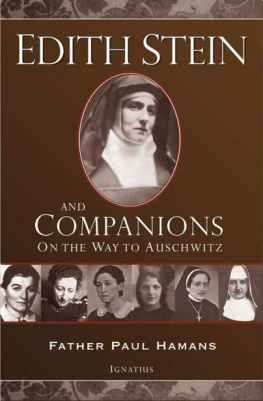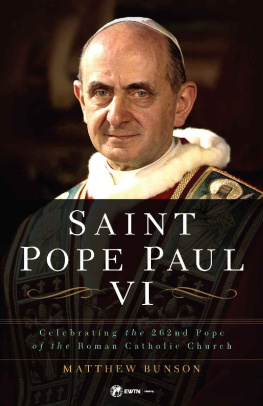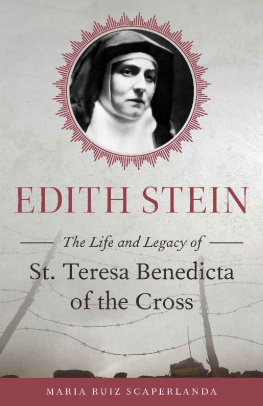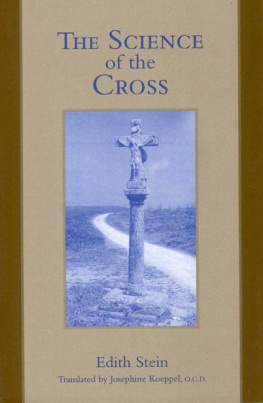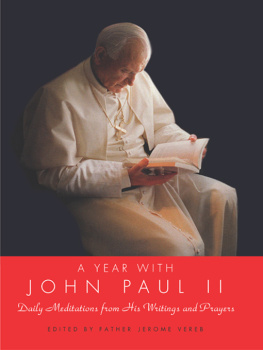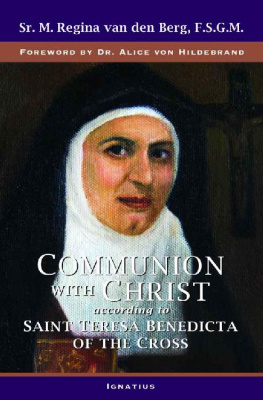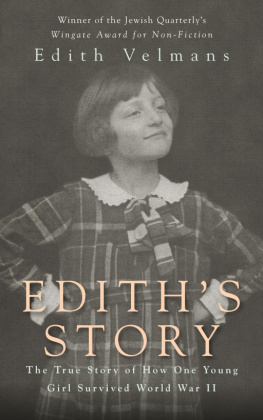EDITH STEIN AND COMPANIONS
ON THE WAY TO AUSCHWITZ
EDITH STEIN
AND COMPANIONS
On the Way to Auschwitz
BY FATHER PAUL HAMANS
Translated by Sister M. Regina van den Berg, F.S.G.M .
Foreword by Ralph McInerny
IGNATIUS PRESS SAN FRANCISCO
This book is based on the book by P. Haman
entitled Getuigen voor Christus:
Rooms-katholieke bloedgetuigen uit Nederland in de twintigste eeuw
published in s-Hertogenbosch, The Netherlands, 2008
Cover photographs, left to right:
Rosa Marie Agnes Adelheid Stein
Elvira Maria Josepha Sanders-Platz
Dr. Ruth Renate Frederike Kantorowicz
(Photo: Als een brandende toorts , 281)
Helene Luise (Leni) Bock
Alice Maria Reis
(Photo Als een brandende toorts , 281)
Sister Mirjam Michaelis, C.S.J.
(Photo: Schwester Mirjam Michaelis , 28)
Cover design by Riz Boncan Marsella
2010 Ignatius Press, San Francisco
All rights reserved
ISBN 978-1-58617-336-4
Library of Congress Control Number 2009930113
Printed in the United States of America
CONTENTS
The Murder of Catholic Jews in Response to the Dutch Bishops
The Stein Sisters
Saint Teresa Benedicta of the Cross, O.C.D.
Rosa Maria Agnes Adelheid Stein
Dr. Ruth Renate Frederike Kantorowicz
The Goldschmidt Sisters
Annemarie Louise Sara
Elfriede Karoline Ida Sara
Alice Maria Reis
Sister Maria Aloysia Lwenfels, P.H.J.C.
Sister Mirjam Michaelis, C.S.J. (Trier)
The Lb Family
Sister Hedwigis, O.C.S.O.
Father Ignatius, O.C.S.O.
Brother Linus, O.C.S.O.
Sister Maria-Theresia, O.C.S.O
Father Nivardus, O.C.S.O.
Hans Jozef
Dr. Lisamaria Meirowsky
The Bock Family
Sister Charitas, S.S.C.J.
Edith
Helene Luise
Hermine Merkelbach-Van Enkhuizen-Grnbaum
Elvira Maria Josepha Sanders-Platz
The Hamburger (de Man) Family
Brother Wolfgang Rosenbaum, O.F.M.
Sister Judith Mendes da Costa, O.P.
FOREWORD
Once, in monasteries, religious houses, and seminaries, the Roman Martyrology was read in the refectory before meals. Each day some of those who had given their lives in witness to the faith were commemorated by name, and often the tortures they underwent were described. Each days entry ended with a sentence beginning et alibi aliorum plurimorum sanctorum.... And elsewhere many other saints.... This tradition continues in some monasteries.
We may feel sad for all the anonymous martyrs gathered into that commodious final sentence, but that would be a mistake. They are all entered in the Book of Life, and the names of each are known to God. For all that, it is important for us, not for them, that the names and sufferings of some be explicitly known by us. The saints are put before us as models of the Christian life, and martyrs are the ultimate models. We need to know more about some of them.
In this remarkable book, Dr. Paul Hamans, Father Hamans, has undertaken the onerous task of compiling biographies, often accompanied by photographs, of many of the religious and laity who were rounded up from their various convents and monasteries and homes on the same day as Saint Edith Stein, August 2, 1942; most of them were taken to the Amersfoort concentration camp and from there put on trains to Auschwitz, where the majority, soon after their arrival at the camp, were gassed and buried in a common grave between August 9 and September 30, 1942. They were all Catholic Jews, and their arrest was in retaliation for the letter of the Catholic bishops of the Netherlands that was read from the pulpits of all churches on July 26, 1942.
Over the past few years, in striking contrast to contemporary acknowledgments and the magnificent book of Jewish theologian and historian Pinchas Lapide, many authors have accused the Church of silence during the Nazi persecution of the Jews. None of the counter-evidence to this shameful thesis has had any effect on the critics. The experience of Jews in the Netherlands, particularly Catholic Jews, is eloquent witness of what could result from public condemnation of the Nazis. The victims whose stories are included in this book were told that they were rounded up in direct retaliation of the condemnation of the Nazi final solution by the Dutch bishops. Elsewhere, as was once acknowledged and celebrated, the Church in many ways, and in many countries, provided the principal help to European Jews. Indeed, the Catholic Church, under the leadership of Pope Pius XII, is credited by Lapide with saving the lives of some 860,000 Jews. These efforts were effective largely because they were not accompanied by noisy public declarations. With the appearance of the mendacious play of Rolf Hochhuth, The Deputy, in 1963, the tide turned, and a series of progressively more intemperate accusations against the Church and Pius XII began to appear. Some Jews reacted to mention of the non-Jewish victims of the Nazi persecution as if it were in some way an effort to diminish the tragedy that had befallen the Jewish people under the reign of Hitler. There were even objections from some Catholics when Edith Stein was canonized and characterized as a martyr. Their argument was that she was put to death as a Jew, not as a Catholic. And some sad souls objected to acknowledgment of what had happened to Catholic Jews like Edith Stein and her companions. This book is an indirect reply to such criticisms and will speak to all who have ears with which to hear.
That the ultimate sacrifice of the Catholic Jews arrested in the wake of the Dutch bishops protest should become a cause of controversy is a sad indictment of these last days. But it cannot touch the nobility and holy resignation with which they met their end. Pondering the people commemorated in this book should be an occasion, not for argument, but for edification. Father Hamans has put us in his debt for having taken on the enormous task of making them flesh-and-blood persons for his readers. During the ordeal, one nun wrote to her superior that they had all become numbers to their captors. Lists had been drawn up with diabolical bureaucratic efficiency by the Nazis, which is why the arrests were made so promptly. Thanks to this book, they are no longer mere numbers. Like those mentioned in the Martyrology, their names have been restored. But, again, the importance of that is largely for us. They would have been content, like perhaps millions of others, with the collective mention of the army of martyrs in the Te Deum Laudamus :
Te martyrum candidatus laudat exercitus .
Ralph McInerny
University of Notre Dame
September 2010
INTRODUCTION
In 1994, in preparation for the new millennium, Pope John Paul II asked the local churches to do everything possible to ensure that the memory of those who have suffered martyrdom should be safeguarded. This cataloging of the martyrs names led to the publication of a book, the last portion of which concerned murdered Catholic Jews. It is this last section of the Dutch book about the blood witnesses of the twentieth century that is made available to the American public in the present publication.
The Nazis wanted to exterminate all Jews. This group of Jews who had become Catholic forms a separate whole. They became companions because they were arrested and murdered for the same reason. On July 26, 1942, the Dutch bishops, together with the Protestant denominations, publicly protested against the deportation of Jews. In retribution, the Nazis had more than four hundred Catholic Jews rounded up. Many were soon released, but 113 were murdered. The most well-known of them is surely the Carmelite nun and philosopher Edith Stein, who was canonized by Pope John Paul II on October 11, 1998. It is also widely known that her sister Rosa suffered the same fate.
Next page
